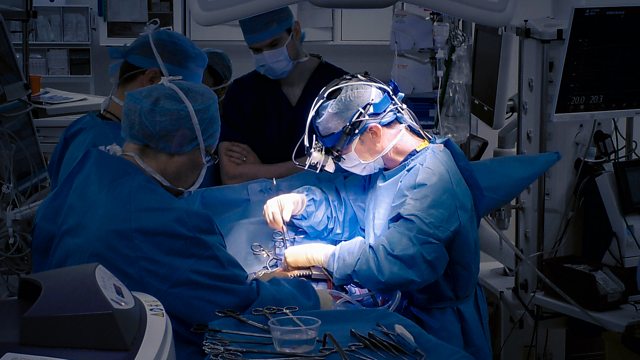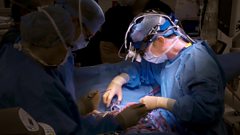Episode 1
The award-winning series returns to show more pioneering work from some of the UK’s top surgeons. A patient’s body is drained of blood to remove life-threatening clots in her lungs
The highly acclaimed series Surgeons: At the Edge of Life returns to reveal the extraordinary and pioneering work of some of the country’s top surgeons. In the UK, three million major operations are carried out every year, and some of the most difficult ones are performed at world-renowned Royal Papworth and Addenbrooke’s hospitals in Cambridge.
Over the past 100 years approximately 50 Nobel Prize winners in chemistry, physiology or medicine have been associated with Cambridge. Situated just metres apart on the Biomedical Campus, the largest centre of medical research and health science in Europe, this series goes behind the hospitals’ theatre doors to show how they push the boundaries of what is medically possible, and to meet the patients whose lives can be transformed by the groundbreaking work of their specialist teams.
In the first episode, David Jenkins, a world-leading surgeon at Royal Papworth, performs one of surgery’s most technically demanding – and extraordinary - operations. Called a pulmonary endarterectomy (PTE), no other hospital in the UK offers this procedure and it will take David’s patient, 54-year-old grandmother Shelly, to the very edge of life.
Shelly has a rare form of hypertension where her body is unable to dissolve blood clots which have travelled to her lungs and are now blocking her pulmonary arteries. More and more clots are building up and without the operation she will die. The only way to remove them is to cool her body to just 20 degrees, stop her heart and drain all the blood from her body. She will be technically dead on the theatre table. David admits that it does seem 'counterintuitive' to make Shelly temporarily dead. 'Is she between life and death? It is that in-between place'.
David has just 20 minutes while Shelly is entirely empty of blood to remove the clots, so he needs to be fast. The cold will protect her during this time because the low temperature slows her cell function, but any longer and lack of oxygen will damage her brain. Shelly will then need to be refilled with blood before David repeats the whole process again on her other lung.
Meanwhile, loving husband Phil sits at home with an agonising wait, trying not to think about worst-case scenarios.
At Addenbrooke’s hospital consultant orthopaedic surgeon, Andrew Carrothers, is also pushing at the boundaries of medical science with a complex operation that he has devised, called the Harrington Plus. Frustrated by the lack of options for patients whose pelvis and hip bones have been badly weakened by cancer, Andrew added a crucial stage to an existing operation to enable cancer patients to walk again.
Invented just four years ago, Andrew is performing the 16th operation on 76-year-old Peter, a geologist who works at the British Museum. Peter was living a full and active life when he suddenly collapsed at home. Peter had fractured his hip, and for the first time learned that he had prostate cancer. The cancer had spread across his bones and weakened them so much that he faced being bed-bound for the rest of his life. Andrew’s new operation should enable Peter to walk again, but it is a procedure with considerable risks including blockages in the lungs’ arteries and heavy blood loss.
In the first part of the operation- the 'Plus' that Andrew created – he must screw a special metal plate into Peter’s cancer-damaged pelvic bone to strengthen it enough to support the weight-bearing load that passes through this part of the body. Next, four metal rods are drilled into the pelvic bone to act as a scaffold for a hip replacement, which is the final part of the procedure.
But the cancer in Peter’s pelvis is extensive, and every move Andrew makes causes bleeding from the cancerous tissue. Halfway through the operation, Peter is bleeding faster than they can replace it in transfusions. His blood pressure is dropping dangerously low, so much so that he enters 'peri-arrest' – the state just before full cardiac arrest. The emergency buzzer is pressed and an emergency response team floods into theatre. He has so little blood circulating in his body, his heart can’t pump properly. If it stops, they won’t be able to resuscitate him.
As 15 specialists, led by consultant anaesthetist Ronan O’Leary, work quickly to get the heart working again with adrenaline and blood transfusions, Andrew and fellow surgeon Mukai can’t stop the operation. The top of Peter’s femur has been removed and they must finish the procedure if he is to ever walk again.
Andrew has devised this operation, and the responsibility of having Peter’s life in his hands weighs heavy. 'You’re suppressing the fear factor', he admits, so that he can concentrate on completing the technically difficult operation while his colleagues work fast around him to save Peter’s life.
Addenbrooke’s Hospital is part of the Cambridge University NHS Foundation Trust and Royal Papworth Hospital NHS Foundation Trust is the country’s leading cardiothoracic centre.
Last on
More episodes
Previous
You are at the first episode
Next
Clip
-
![]()
Draining blood from a patient's body
Duration: 01:21
Music Played
Timings (where shown) are from the start of the programme in hours and minutes
-
![]() 00:04
00:04Alex & Sierra
Back To You
Credits
| Role | Contributor |
|---|---|
| Narrator | Shaun Dooley |
| Executive Producer | Jo Hughes |
| Executive Producer | Ros Ponder |
| Executive Producer | Richard Bond |
| Series Producer | Daniel Barry |
| Director | Alex Kohler |
| Editor | Alex Hay |
| Production Manager | Isabelle Burn |
| Director | Nick Shaw |
| Director | Rohan Latchman |
| Director | Howard Holloway |
| Producer | Emily Bunt |
| Production Company | Dragonfly Film and Television |
Broadcasts
- Tue 6 Oct 2020 21:00
- Thu 8 Oct 2020 23:30�������� Two except Northern Ireland & Northern Ireland HD
- Sat 24 Oct 2020 01:15



